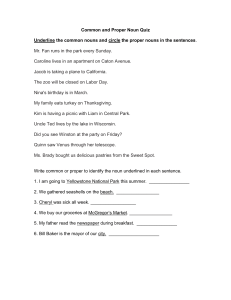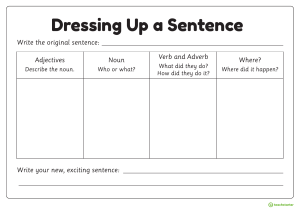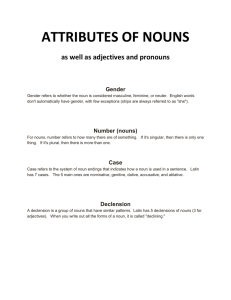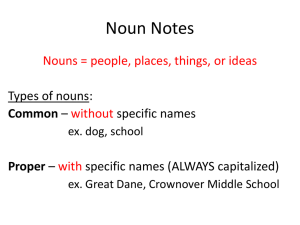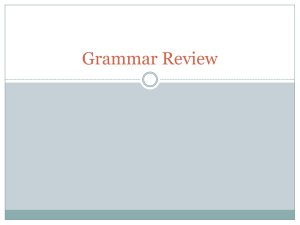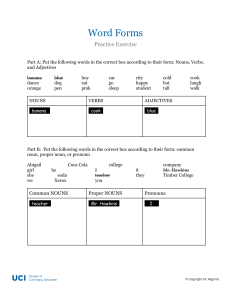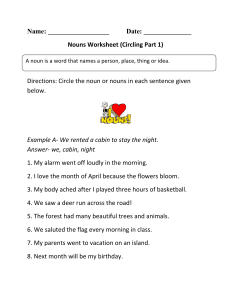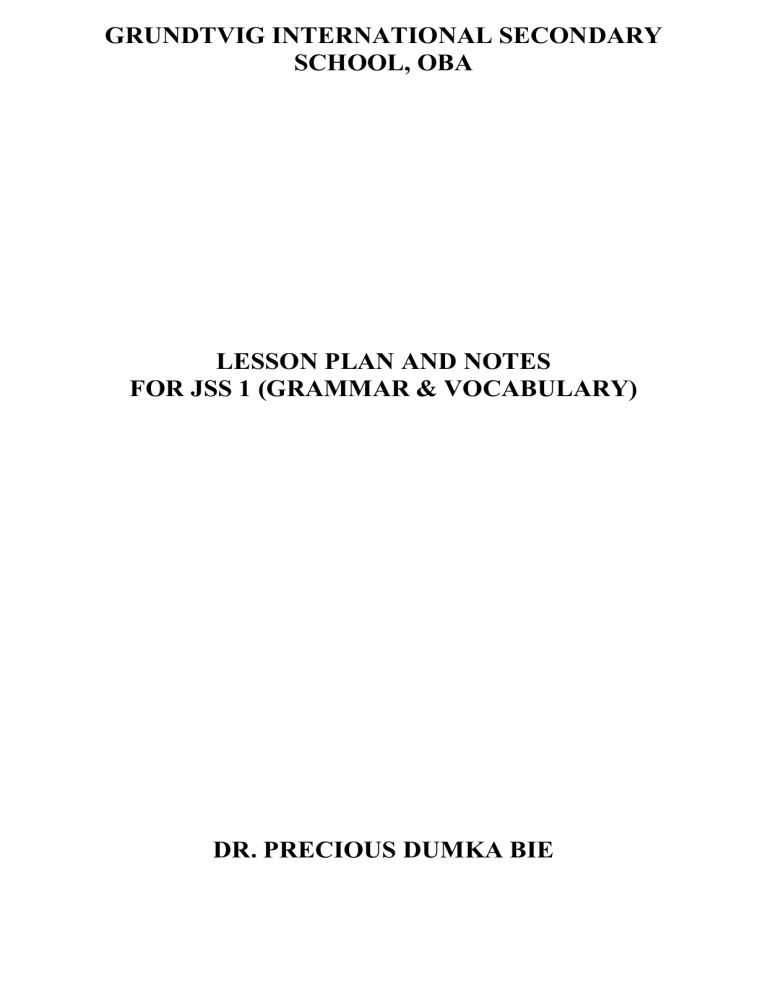
GRUNDTVIG INTERNATIONAL SECONDARY SCHOOL, OBA LESSON PLAN AND NOTES FOR JSS 1 (GRAMMAR & VOCABULARY) DR. PRECIOUS DUMKA BIE 1. 2. 3. 4. 5. 6. 7. 8. 9. 10. 11. 12. 13. SCHEME OF WORK ON GRAMMAR & VOCABULARY Orientation/Scheme of work 2. Structure: Nouns and Types ii. Nouns and its types cntd. Structure: Adjectives – possessive adjectives. ii. Vocabulary: words associated with family Structure: quantifiers ii. Words Associated with Schools Vocabulary Development: words associated with school ii. Phrase: noun phrase Grammar: punctuation marks ii. Punctuation marks cntd. MID – TERM BREAK Structure: partitives ii. vocabulary development: words associated with market Grammar: functions of nouns ii. Structure: Subject, verb and object Pronouns: meaning and types ii. Types of pronouns cntd. Vocabulary Development: words associated with road transport ii. More about nouns: countable and uncountable nouns Revisions 13. Exams/vacation GRUNDTVIG INTERNATIONAL SECONDARY SCHOOL, OBA LESSON NOTES AND PLAN FOR WEEK 2 PRECIOUS DUMKA BIE CLASS: JSS 1 AVERAGE AGE: 10 Years DURATION: 40 Minutes Subject: Grammar &Vocabulary Gender: Mixed Topic: Structure: Nouns and Types DATE: Keywords: nouns SPECIFIC OBJECTIVES: By the end of the lesson, the students should be able to: 1. define nouns 2. list examples of nouns 3. explain types of nouns. INSTRUCTIONAL MATERIALS: Textbook, projector, etc. ENTRY BEHAVIOUR: The students have heard the word “noun”. SET INDUCTION: The teacher sets induce the students by asking some questions. INSTRUCTIONAL METHODOLOGY: discussion, explanation, demonstration and questioning. LESSON PROCEDURE Step I: Defining Nouns. Teacher’s Activity: The teacher starts by explaining that the word ‘noun’ comes from the Greek word onoma meaning name. It there means that we can define noun as a name we can give to anything that exists. A noun is a word that names something, such as a person, place, thing, or idea. In a sentence, nouns can play the role of subject, direct object, indirect object, subject complement, object complement, appositive, or modifier. Step II: Examples of Nouns. The following are some examples of noun: person – Mary, Jude, Sonia, Samuel place – Lagos, Oba, Onitsha, Grundtvig International Secondary School, Port Harcourt etc thing – car, computer, food, pen, cup knife, stove etc. animals – cat, goat, fish. Dove lion, snake etc. Step III: Types of Nouns. The following are some types of nouns: proper, common, abstract and collective nouns. 1. Proper nouns: These are the names of particular people, places, things, or ideas. They are always written in capital letters at the initials to differentiate them from common nouns. They are: a. Names of Human Beings: Mary, Sandra, Chioma, Chukwudi, etc. b. Days of the Week: Monday, Tuesday, Wednesday, Thursday, Sunday c. Towns: Oba, Onitsha, Lagos, Nnewi, Ojoto etc d. Titles of Books: New Oxford Secondary English Course for Junior Secondary School, Things Fall Apart, Tell it to Parents, Costly Mistake etc e. Titles of Movies: Merlin, Mary and Clara, Flash, Her Mother’s Daughter etc. f. Natural Resources: like rivers, oceans, deserts etc. Niger River, River Benue, Mountain Everest, Sahara Desert, Atlantic Ocean etc. g. Countries: Nigeria, Ghana, South Africa, London, America h. State: Anambra Enugu, Imo, Rivers, Kano etc i. Subjects: English Language, Civic Education, Government, History etc j. Institutions like: i. Religious Institutions: St. Mary Catholic Church, Salvation Ministries, Assemblies of God etc. ii. Academic Institutions: Grundtvig International Secondary School, University of Nigeria, Nsukka, Infant Jesus Nursery and Primary School, Awka, Community Secondary School, Oba etc. iii. Financial Institutions: Fidelity Bank Plc, Emros Business Centre, Peace Mass, Diamond Bank etc iv. Legal Institutions: Ministry of Justice, Federal Ministry of Education etc. v. Strees/Roads: Owerri Road, Port Harcourt Road, Iweka Road, Nnewi Road, Nkiri Street etc. vi. Courses/Professions: Engineering, Law, Business Management, Medicine and Surgery, Pharmacy etc. 2. Common Nouns: These are names we give to things, persons or places that have the same characteristics they share in common. Examples are women, boys, animals, cars, human beings, computers, offices, teachers, doctors, nurses etc. Types of Noun Cont’d 3. Collective Nouns: These are names we give to things, animals or persons that exist in groups e.g. class, set, herd, galaxy staff, army, battalion, group, fleet, flock, board, brood, brunch, bundle, family, congregation, audience, cast, crew etc. a. The class is noisy. b. Jesus says, “I know my flock”. c. I saw a group of students. d. Our set is graduating today. e. There is a galaxy of stars in Heaven. 4. Abstract: These are nouns that cannot be seen or touched with bare hands e.g. peace, anger, unity wisdom, stupidity, education, difference, support etc. i. I have a great joy today. ii. Happiness is free. iii. Education is light. iv. Anger destroys many things. v. Wisdom cannot be bought. 5. Concrete Nouns: A concrete noun is a noun that refers to a physical thing, person, or place—something or someone that can be perceived with the five senses (touch, hearing, sight, smell, and taste). Examples include “pencil,” “dog, broom, glasses. Students’ Activity: The students listen carefully as he explains and ask questions. EVALUATION: The teacher asks the students the following questions: 1. define nouns 2. list examples of nouns 3. explain types of nouns. Students’ Activity: The students attempt to answer the questions. Reference: Banjo, Ayo et al. New Oxford Secondary English Course for Junior Secondary School. Uni., Press: 2020. SUMMARY/CONCLUSION The teacher briefly goes over the lesson and writes the notes on the board for the students to copy into their notebooks. Signed:………………………………… GRUNDTVIG INTERNATIONAL SECONDARY SCHOOL, OBA LESSON NOTES AND PLAN FOR WEEK 3 PRECIOUS DUMKA BIE CLASS: JSS 1 AVERAGE AGE: 10 Years DURATION: 40 Minutes Subject: Grammar &Vocabulary Gender: Mixed Topic: Adjectives & Vocabulary Associated with Family DATE: Keywords: adjectives, vocabulary, family SPECIFIC OBJECTIVES: By the end of the lesson, the students should be able to: 1. 2. 3. 4. define adjectives. explain types of adjectives with examples. define vocabulary. explain vocabulary associated with family. INSTRUCTIONAL MATERIALS: Textbook, projector, etc. ENTRY BEHAVIOUR: The students have heard the word “adjectives and vocabulary”. SET INDUCTION: The teacher sets induce the students by asking some questions. INSTRUCTIONAL METHODOLOGY: discussion, explanation, demonstration and questioning. LESSON PROCEDURE Step I: What is Adjective? Teacher’s Activity: The teacher begins by defining adjective as a part of speech that can be used to describe or provide more information about a noun or pronoun. It is a word that describes a person or thing, for example ‘big’, ‘red’ and ‘clever’ in a big house, red wine and a clever idea. Step 2: Types of Adjectives The following are some types of adjectives: i. Qualitative Adjectives: These are adjectives which describe or show the qualities in a noun or pronoun of living beings or non-living things. They answer the question, what kind? They are mostly abstract and perceived through our senses. Examples: boring, interesting, scary, funny, dark, fair, silky, long etc. a. My sister is a beautiful girl. b. There are boring people in my classroom. c. The orange is so sour. ii. Possessive Adjectives: These are adjectives that indicate ownership (possession). E.g your, our, her, his, their, my, its. Eg: a. The dog ate its food. b. This is my brother. c. I saw your mother. iii. Quantitative Adjectives: They are adjectives that describe quantity or amount of something. E.g. Two, three, all, enough, small big, many etc. a. I took enough water. b. She needs all the money. c. Many people were hailing him. iv. Demonstrative Adjectives: These are adjectives that show the directions of nouns and pronouns, e.g this, that, those, and these. a. This shark is pregnant. b. c. d. That lady looks worried. Take these ones away. Put those tins in the cupboard. Step 3: Vocabulary Vocabulary means the words of English Language that a learner possesses. Vocabulary development therefore, refers to the efforts made towards increasing the number of words of English Language that one has. The ways of developing our vocabularies are: i. The use of dictionaries ii. Extensive reading: Reading outside the recommended textbooks. iii. Intensive reading: reading within the recommended textbooks. iv. Skimming and Scanning through newspapers, journals and magazines. v. Reading registers of different fields of human endeavours. Step 4: Words Associated with Family 1. Sibling: A person's brother or sister 2. Spouse: A person's partner in marriage 3. Kinship: family relationship 4. Parents: a person who is a father or mother. 5. Grandparents: A parent of your father or mother. 6. Mother: A female parent 7. Father: A male parent. 8. Uncle/aunt: The brother of your father or mother. 9. Cousin: A child of your uncle or aunt 10. Nephew: A son of your brother or sister 11. Niece: A daughter of your brother or sister. EVALUATION: The teacher asks the students the following questions: 1. 2. 3. 4. define adjectives. explain types of adjectives with examples. define vocabulary. explain vocabulary associated with family. Students’ Activity: The students attempt to answer the questions. Reference: Banjo, Ayo et al. New Oxford Secondary English Course for Junior Secondary School. Uni., Press: 2020. SUMMARY/CONCLUSION The teacher briefly goes over the lesson and writes the notes on the board for the students to copy into their notebooks. Signed:………………………………… GRUNDTVIG INTERNATIONAL SECONDARY SCHOOL, OBA LESSON NOTES AND PLAN FOR WEEK 4 PRECIOUS DUMKA BIE CLASS: JSS 1 AVERAGE AGE: 10 Years DURATION: 40 Minutes Subject: Grammar &Vocabulary Gender: Mixed Topic: Quantifiers DATE: Keywords: quantifiers, SPECIFIC OBJECTIVES: By the end of the lesson, the students should be able to: 1. define quantifiers. 2. explain the uses of quantifiers. 3. discuss possessive adjectives. INSTRUCTIONAL MATERIALS: Textbook, projector, etc. ENTRY BEHAVIOUR: The students have heard the word quantifiers. SET INDUCTION: The teacher sets induce the students by asking some questions. INSTRUCTIONAL METHODOLOGY: discussion, explanation, demonstration and questioning. LESSON PROCEDURE Step I: What are Quantifiers? Teacher’s Activity: The teacher begins by defining quantifiers as words or phrases used before nouns to indicate the amount or quantity of something without saying the actual number. They usually go before nouns to express the amount of object. Their examples are each, every. a lot, several, little, many, most, few, etc. Step 2: Uses of Quantifiers 1. Each and Every: These ones are used with singular nouns. E.g a. i. Every child in the school was immunized. ii. Each student was given a prize. iii. Every country has a president. b. A lot, both, some, a few, most, more, several: are used with plural countable nouns. E.g i. Both students fought in the class. ii. There are many mangoes in the box. iii. A lot of birds’ nests are on the tree. c. A little, much, lots of, more, little: are used with plural uncountable nouns, e.g i. There is much salt in the food. ii. There is a little water in the kettle. iii. I spent a lot of money today. Step 3 Possessive Adjectives It is a word that is used to describe the ownership or possession of something by someone. The following are the examples: 1. Ram is my brother. 2. Mikki told me that he met your son in Kent. 3. Aldrin and I went to Tambaram on his bike. 4. Shadow is their pet dog. EVALUATION: The teacher asks the students the following questions: 1. define quantifiers. 2. explain the uses of quantifiers. 3. discuss possessive adjectives. Students’ Activity: The students attempt to answer the questions. Reference: Banjo, Ayo et al. New Oxford Secondary English Course for Junior Secondary School. Uni., Press: 2020. SUMMARY/CONCLUSION The teacher briefly goes over the lesson and writes the notes on the board for the students to copy into their notebooks. Signed:………………………………… GRUNDTVIG INTERNATIONAL SECONDARY SCHOOL, OBA LESSON NOTES AND PLAN FOR WEEK 5 PRECIOUS DUMKA BIE CLASS: JSS 1 AVERAGE AGE: 10 Years DURATION: 40 Minutes Subject: Grammar &Vocabulary Gender: Mixed Topic: Words Associated with School & Phrase: Noun Phrase DATE: Keywords: school, phrase, noun SPECIFIC OBJECTIVES: By the end of the lesson, the students should be able to: 1. 2. 3. 4. define school. explain some words associated with school. define noun phrase. list examples of noun phrases. INSTRUCTIONAL MATERIALS: Textbook, projector, etc. ENTRY BEHAVIOUR: The students have heard the word noun phrase. SET INDUCTION: The teacher sets induce the students by asking some questions. INSTRUCTIONAL METHODOLOGY: discussion, explanation, demonstration and questioning. LESSON PROCEDURE Step I: What is a School? Teacher’s Activity: The teacher begins by defining a school as a formal setting where teaching and learning takes place. Step 2: The following are words associated with school: Boarding School: A school where students can live during the school year. Day School: A school where students who stay at home attend schools from their houses during the day. Classroom: A room where teaching and learning takes place. Classwork: It is an activity given to students in class during lesson by their teachers. Teacher: A person who teaches the students. Blackboard: It is a structure in the classroom where teachers write on. Markers: It is a device used by the teachers to write on the blackboard. Principal: It is a person in charge of a school Worksheets: A paper listing questions or tasks for students. Exams: Exams are tests given to students to ascertain whether knowledge has taken place. Step 3: Noun Phrase A phrase is simply a group of words that form a part of a sentence without a finite verb. For example: "in the dark night" or "within the bustling crowd." A noun phrase is a small group of words which contains a noun along with modifying words for that noun. The phrase acts like the subject or object of the sentence. Even a simple modifier, such as a number or an article like “the” or “a,” turns the group of words into a noun phrase. Step 3: Examples of Noun Phrases the house my gray dog the teacher the clever child The above cannot become full sentences; instead, they show that noun phrases are parts of longer sentences, such as: The house was brand-new. I love my gray dog. The teacher cheered on the clever child. EVALUATION: The teacher asks the students the following questions: 1. 2. 3. 4. define school. explain some words associated with school. define noun phrase. list examples of noun phrases. Students’ Activity: The students attempt to answer the questions. Reference: Banjo, Ayo et al. New Oxford Secondary English Course for Junior Secondary School. Uni., Press: 2020. SUMMARY/CONCLUSION The teacher briefly goes over the lesson and writes the notes on the board for the students to copy into their notebooks. Signed:………………………………… GRUNDTVIG INTERNATIONAL SECONDARY SCHOOL, OBA LESSON NOTES AND PLAN FOR WEEK 6 PRECIOUS DUMKA BIE CLASS: JSS 1 AVERAGE AGE: 10 Years DURATION: 40 Minutes Subject: Grammar &Vocabulary Gender: Mixed Topic: Punctuation Marks DATE: Keywords: SPECIFIC OBJECTIVES: By the end of the lesson, the students should be able to: 1. 2. 3. define punctuation marks explain types of punctuation marks use some in sentences. INSTRUCTIONAL MATERIALS: Textbook, projector, etc. ENTRY BEHAVIOUR: The students have heard the word punctuation marks. SET INDUCTION: The teacher sets induce the students by asking some questions. INSTRUCTIONAL METHODOLOGY: discussion, explanation, demonstration and questioning. LESSON PROCEDURE Step I: What are Punctuation Marks? Teacher’s Activity: The teacher begins by defining punctuation marks as signs used in writing to divide texts into phrases and sentences and make meaning clear. When writing, you must use punctuation marks such as commas, full stop, question marks etc to make your meaning clear. The absence or presence of a comma can change the entire meaning of a sentence. Example, a. Let us eat grandma b. Let us eat, grandma. Step 2: Types of Punctuation Marks Types of Punctuation Symbol of the Type of Punctuation Full stop . Question mark ? Exclamation Mark ! Comma , Colon : Semicolon ; Slash / Dash - Hyphen - Brackets [] Parenthesis () Apostrophe ' Speech Marks (quotation marks) "" Ellipsis ... Step 3: Using Some in Sentences 1. Full stops/periods: Full stops mark the end of a sentence. E.g. 1. I walked there. 2. My mother is here. Full stops may also be used in acronyms and abbreviations between each letter. U.S.A., 9 A.M. and i.e. 2. Question marks: Question marks are used to end interrogative sentences. Some examples could include: 1. What is the capital city of England? 2. Who is going out this evening? 3. Commas: Commas are used to insert a pause into a sentence. They are primarily used to help in clarity and to introduce a list of items. 2. I enjoyed the singers, and I loved the dancers. 3. I had eggs, toast, and orange juice. 4. Hyphen (-): Not to be confused with a dash, a hyphen is used in compound words when two or more words are connected. 1. Step-by-step 2. Mother-in-law 3. Ex-boyfriend 5. Apostrophe (‘) Apostrophes are meant to show that a letter or letters have been omitted and also to indicate the possessive or contractions. Examples: 1. I’ve been working from home for 6 months and it’s great. 2. Rebecca’s dog had surgery yesterday. EVALUATION: The teacher asks the students the following questions: 1. define punctuation marks 2. explain types of punctuation marks 3. use some in sentences. Students’ Activity: The students attempt to answer the questions. Reference: Banjo, Ayo et al. New Oxford Secondary English Course for Junior Secondary School. Uni., Press: 2020. SUMMARY/CONCLUSION The teacher briefly goes over the lesson and writes the notes on the board for the students to copy into their notebooks. Signed:………………………………… GRUNDTVIG INTERNATIONAL SECONDARY SCHOOL, OBA LESSON NOTES AND PLAN FOR WEEK 8 PRECIOUS DUMKA BIE CLASS: JSS 1 AVERAGE AGE: 10 Years DURATION: 40 Minutes Subject: Grammar &Vocabulary Gender: Mixed Topic: Partitives & Words Associated with Market DATE: Keywords: SPECIFIC OBJECTIVES: By the end of the lesson, the students should be able to: 1. 2. 3. 4. define partitives. list examples of partitives. use partitives in sentences. explain words associated with market. INSTRUCTIONAL MATERIALS: Textbook, projector, etc. ENTRY BEHAVIOUR: The students have heard the word partitives. SET INDUCTION: The teacher sets induce the students by asking some questions. INSTRUCTIONAL METHODOLOGY: discussion, explanation, demonstration and questioning. LESSON PROCEDURE Step I: Partitives Teacher’s Activity: The teacher begins by saying in English grammar, a partitive is a word or phrase (such as "some of" or "a slice of") that shows a part or quantity of something as different from a whole. A partitive is also called "partitive noun" or "partitive noun phrase". Step 2: Examples of Partitives. a glass of , a loaf of, two pieces of, a slice of, a bowl of, a pile of, a batch of, a kilo of, a tube of, a library of, a jar of, a deck of, a can of etc. Step 3: Using Partitives in Sentences. 1. 2. 3. 4. 5. John gave her a glass of water. She will buy a loaf of bread. I will have two pieces of pie. We have taken two slices of cake. I will have a bowl of your new soup. Step 4: Words Associated with Market. A market is an open place where commercial activities (buying and selling) take place. The words associated with market are: a. Shop: a building or part of it where one can buy goods and services. b. Seller: One who exchange goods and services for money. c. Buyer: Someone who buys things from the market. d. Wholesaler: Someone who buys goods in large quantities and sells it to retailers in bulks. e. Retailers: He buys goods in large quantities and sells in bits to consumers. f. Salesperson: A person employed to represent a business and who sells it in merchandise to customers. g. Bargain (Verb): To negotiate prices and conditions. h. Haggle: To argue with someone about the price of something in order to reach an agreement. i. Trader: A person whose job is buying and selling of goods. j. Hawker: A person who sells things by going from one place to another. k. Change: The money you get back when you have paid more money than the cost of something. l. Discount: An amount taken off the usual cost of something. m. Balance: The amount you still need to pay for the price of something. EVALUATION: The teacher asks the students the following questions: . Students’ Activity: The students attempt to answer the questions. Reference: Banjo, Ayo et al. New Oxford Secondary English Course for Junior Secondary School. Uni., Press: 2020. SUMMARY/CONCLUSION The teacher briefly goes over the lesson and writes the notes on the board for the students to copy into their notebooks. Signed:………………………………… GRUNDTVIG INTERNATIONAL SECONDARY SCHOOL, OBA LESSON NOTES AND PLAN FOR WEEK 9 PRECIOUS DUMKA BIE CLASS: JSS 1 AVERAGE AGE: 10 Years DURATION: 40 Minutes Subject: Grammar &Vocabulary Gender: Mixed Topic: Functions of Nouns & the Concept of Subject, Verb and Object DATE: Keywords: SPECIFIC OBJECTIVES: By the end of the lesson, the students should be able to: 1. 2. 3. define nouns discuss the functions of nouns define subject, verb and object INSTRUCTIONAL MATERIALS: Textbook, projector, etc. ENTRY BEHAVIOUR: The students have heard the word nouns SET INDUCTION: The teacher sets induce the students by asking some questions. INSTRUCTIONAL METHODOLOGY: discussion, explanation, demonstration and questioning. LESSON PROCEDURE Step I: Define Nouns Teacher’s Activity: The teacher defines noun as a name. It is the name given to anything. Step 2: Functions of Nouns Step 2: identifying Grammatical Functions of a Noun and Noun Phrases 1. Subject of a Sentence: A subject is a word, phrase, or clause that performs the action of or acts upon the verb. For example, the following italicized noun phrases function as subjects. i. ii. iii. The baby cried. Dogs and cats make excellent pets. I will have to study English grammar. 2. Subject Complements: A subject complement is a word, phrase, or clause that follows a copular or linking verb and describes the subject of a clause. i. ii. iii. My grandfather is a farmer. Our favourite pets are dogs with short hair. The woman you are looking for is her. 3. Direct Object of a Verb: A direct object is a word, phrase, or clause that follows a transitive verb and answers the question “who?” or “what?” and receives the action of the verb. For example, the following italicized noun phrases function as direct objects the verbs. i. ii. iii. The children ate all the cookies. My professor recommended a captivating book. The man has always hated mice and rats. 4. Indirect Object of a Verb: An indirect object is a word, phrase, or clause that indicates to or for whom or what the action of a transitive verb is performed. For example, the following italicized noun phrases function as indirect objects: i. My husband bought me flowers. ii. The child drew his mother a picture. iii. The salesman sold the company new computers. . 5. Object Complements: Object complements are nouns, pronouns, noun phrases, adjectives, and adjective phrases that directly follow and modify the direct object. For example: i. ii. iii. We consider our puppy our baby. My aunt calls my uncle sweetheart. America elected Joe Biden president. 6. Prepositional Complement: A prepositional complement is a word, phrase, or clause that directly follows a preposition and completes the meaning of the prepositional phrase. Examples: i. ii. iii. My husband bought flowers for me. We missed our flight because of the lengthy delay. The book is under the table. 7. Appositive: An appositive is a word, phrase, or clause that modifies or explains another noun phrase. Examples:s i. ii. iii. My grandfather, the farmer, bought more farmland. The teacher, my uncle, assigns a lot of homework. The musician, Davido, is rich. a. Subject: A subject is any noun, pronoun or noun phrase that does the action in a sentence. It is most often found in the beginning of a sentence. Examples: Cathy will be baking the cake for the birthday party. 2. The postman has not been seen for a few days now. 3. You have cleared the examination. 4. Did she find the book she was looking for? 1. b. c. Verb: A ‘verb’ is a word or group of words that express an action (such as eat), an event (such as happen) or a state (such as exist)”. Examples: walk, run, talk, sit, write Jog etc. Object: An object is a noun or a pronoun that is acted upon by a verb or a preposition. Example: 1. Jack saw a ghost. 2. I was sat with a werewolf. 3. She was living with her. EVALUATION: The teacher asks the students the following questions: 1. define nouns 2. discuss the functions of nouns 3. define subject, verb and object Students’ Activity: The students attempt to answer the questions. Reference: Banjo, Ayo et al. New Oxford Secondary English Course for Junior Secondary School. Uni., Press: 2020. SUMMARY/CONCLUSION The teacher briefly goes over the lesson and writes the notes on the board for the students to copy into their notebooks. Signed:………………………………… GRUNDTVIG INTERNATIONAL SECONDARY SCHOOL, OBA LESSON NOTES AND PLAN FOR WEEK 10 PRECIOUS DUMKA BIE CLASS: JSS 1 AVERAGE AGE: 10 Years DURATION: 40 Minutes Subject: Grammar &Vocabulary Gender: Mixed Topic: Pronouns: Meaning and Types and Words Associated with Road Transport DATE: Keywords: SPECIFIC OBJECTIVES: By the end of the lesson, the students should be able to: 1. 2. 3. define pronouns discuss types of pronouns explain words associated with road transportation INSTRUCTIONAL MATERIALS: Textbook, projector, etc. ENTRY BEHAVIOUR: The students have heard the word pronouns SET INDUCTION: The teacher sets induce the students by asking some questions. INSTRUCTIONAL METHODOLOGY: discussion, explanation, demonstration and questioning. LESSON PROCEDURE Step I: Defining Pronouns Teacher’s Activity: The teacher defines pronouns as words used in place of nouns in sentences so as to avoid repetitions, e.g he, it, him etc. Step 2: Types of Pronouns a. Personal Pronouns: These pronouns are used in place of names of people or things, e.g. he, her, them, we, I, me etc. It is subdivided into three: first person pronoun which is the person speaking, second person pronoun which is the person spoken to and the third person pronoun which is the person being spoken about. A 1st Person (Singular) 1st Person (Plural) Subjective Position I We Objective Position Me Us B 2nd Person (Singular) 2nd Person (Plural) You You You You C 3rd Person (Singular) 3rd Person (Plural) He, She, It They Him, Her, It They Examples: 1. I went to the market (singular sub.) 2. Mum called me yesterday (singular obj.) 3. We went to the church (plural sub.) 4. The teacher advised us (plural obj.) 5. I am talking to you. (2nd person obj.) 6. You are welcome (2nd person sub.) 7. They saw the car (3rd person singular sub.) 8. I gave birth to her (3rd person singular obj.) 9. I gave birth to them (3rd person plural obj.) b. Possessive pronouns: Are used to are: mine, ours, yours, his, hers, theirs. 1. The ball is mine. 2. Yours is at the bedside. 3. The can is his. 4. The pets are hers. 5. The house is theirs. 6. Ours are on the way. indicate ownership (possession). They c. Emphatic Pronouns: These are pronouns that refer to the speaker who or which is usually the subject in the sentence. They are noted with the use of ‘self’ or ‘selves.’ Examples: himself', 'myself' and 'yourself', are trying to emphasize. myself, yourself, herself, himself, himself, itself, ourselves, yourselves, and themselves EVALUATION: The teacher asks the students the following questions: 1 define pronouns 2 discuss types of pronouns 3 explain words associated with road transportation Students’ Activity: The students attempt to answer the questions. Reference: Banjo, Ayo et al. New Oxford Secondary English Course for Junior Secondary School. Uni., Press: 2020. SUMMARY/CONCLUSION The teacher briefly goes over the lesson and writes the notes on the board for the students to copy into their notebooks. Signed:…………………………………
